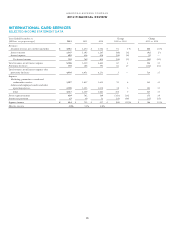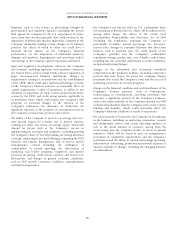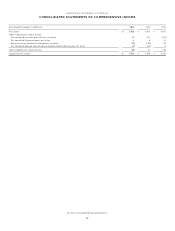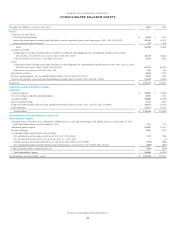American Express 2012 Annual Report Download - page 56
Download and view the complete annual report
Please find page 56 of the 2012 American Express annual report below. You can navigate through the pages in the report by either clicking on the pages listed below, or by using the keyword search tool below to find specific information within the annual report.AMERICAN EXPRESS COMPANY
2012 FINANCIAL REVIEW
CAUTIONARY NOTE REGARDING FORWARD-
LOOKING STATEMENTS
This report includes forward-looking statements within the
meaning of the Private Securities Litigation Reform Act of 1995,
which are subject to risks and uncertainties. The forward-looking
statements, which address the Company’s expected business and
financial performance, among other matters, contain words such
as “believe,” “expect,” “estimate,” “anticipate,” “optimistic,”
“intend,” “plan,” “aim,” “will,” “may,” “should,” “could,”
“would,” “likely,” and similar expressions. Readers are cautioned
not to place undue reliance on these forward-looking statements,
which speak only as of the date on which they are made. The
Company undertakes no obligation to update or revise any
forward-looking statements. Factors that could cause actual
results to differ materially from these forward-looking
statements, include, but are not limited to, the following:
폷the possibility of not achieving the expected timing and
financial impact of the Company’s restructuring plan and
higher than expected employee levels, which could be caused
by factors such as the Company’s ability to mitigate the
operational and other risks posed by planned staff reductions,
the Company’s ability to develop and implement technology
resources to realize cost savings, underestimating hiring needs
related to some of the job positions being eliminated and other
employee needs not currently anticipated, lower than expected
attrition rates and higher than expected redeployment rates;
폷the ability to hold annual operating expense growth to less
than 3 percent for the next two years, which will depend in
part on the Company’s ability to achieve the expected benefits
of the Company’s restructuring plan, which will be impacted
by, among other things, the factors identified above, the
Company’s ability to balance the control and management of
expenses and the maintenance of competitive service levels for
its customers, unanticipated increases in significant categories
of operating expenses, such as consulting or professional fees,
compliance or regulatory-related costs and technology costs,
the payment of monetary damages and penalties,
disgorgement and restitution, the Company’s decision to
increase or decrease discretionary operating expenses
depending on overall business performance, the impact of
changes in foreign currency exchange rates on costs and
results, and the level of acquisition activity and related
expenses;
폷uncertainty in the growth of operating expenses relative to the
growth of revenues in 2013 and subsequent years and the
possibility that the ratio of total expenses to revenues will not
migrate back towards historical levels over time, which will
depend on (i) factors affecting revenue, such as, among other
things, the growth of consumer and business spending on
American Express cards, higher travel commissions and fees,
the growth of and/or higher yields on the loan portfolio and
the development of new revenue opportunities and (ii) the
success of the Company in containing operating expenses,
which will be impacted by, among other things, the factors
identified in the preceding bullet, and in containing other
expenses including the Company’s ability to control and
manage marketing and promotion expenses as described below
as well as expenses related to increased redemptions or other
growth in rewards and cardmember services expenses. Further,
in any period, the ability to grow revenue faster than operating
expenses and the ratio of total expenses to revenues may be
impacted by rapid decreases in revenues that cannot be
matched by decreases in operating expenses;
폷uncertainty in the amount of marketing and promotion
expenses relative to the revenues in 2013 and subsequent years,
which will depend on (i) factors affecting revenue, which will
be impacted by, among other things, the factors identified in
the preceding bullet and (ii) the Company’s ability to control
and manage marketing and promotion expenses as described
below, the availability of opportunities to invest at a higher
level due to favorable business results and changes in
macroeconomic conditions;
폷changes in global economic and business conditions, including
consumer and business spending, the availability and cost of
credit, unemployment and political conditions, all of which
may significantly affect spending on American Express cards,
delinquency rates, loan balances and other aspects of the
Company’sbusinessandresultsofoperations;
폷changes in capital and credit market conditions, including
sovereign creditworthiness, which may significantly affect the
Company’s ability to meet its liquidity needs, access to capital
and cost of capital, including changes in interest rates; changes
in market conditions affecting the valuation of the Company’s
assets; or any reduction in the Company’s credit ratings or
those of its subsidiaries, which could materially increase the
cost and other terms of the Company’s funding, restrict its
access to the capital markets or result in contingent payments
under contracts;
54
























